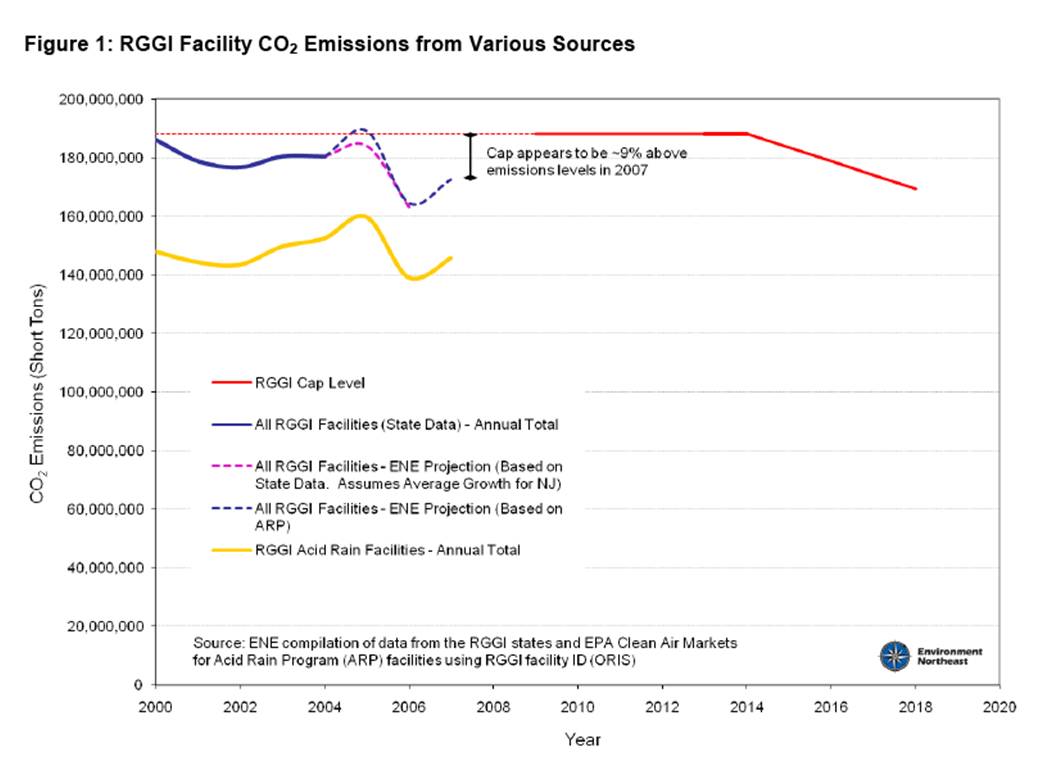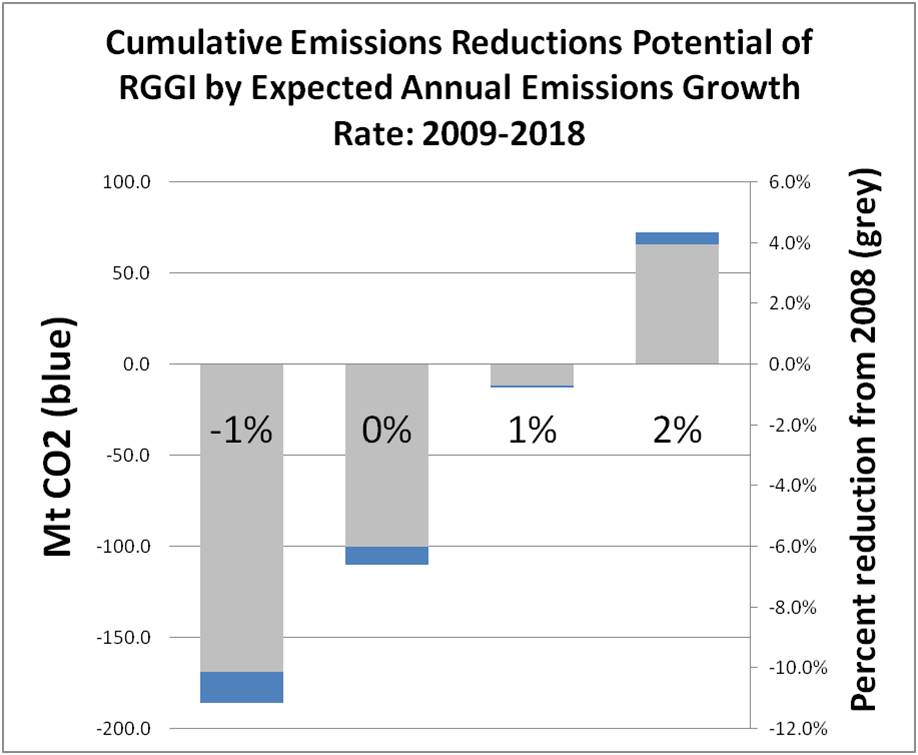Tax and Charade
September 18th, 2008Posted by: Roger Pielke, Jr.
Yesterday’s New York Times had an article on the upcoming carbon dioxide auction of the Regional Greenhouse Gas Initiative (RGGI) of 10 northeastern U.S. states participating in this new cap and trade program (h/t Adam Zemel at the BT blog). The evolving performance of RGGI should add weight to the argument that cap and trade is simply not up to the challenge of reducing greenhouse gas emissions. Here is an excerpt from the NYT article:
The program is due to get off the ground in nine days, but already there are worries that it may fail to reduce pollution substantially in the Northeast, undermining a concept that is being watched carefully by the rest of the country, by Congress and by European regulators. . .
The concept has been praised by environmentalists and state officials. But the emissions cap was based on overestimates of carbon dioxide output, which has dropped sharply from 2005 to 2006 and is on a lower trajectory than anticipated.
This means that there are more emissions permits available than emissions (can you say ETS Phase 1?). From the NYT again:
The trading scheme would hold carbon emissions to 188 million tons annually through 2014, and scale them back by 2.5 percent each year through 2018. The cap was set in 2004, based on analysis by energy experts and some pressure from the regulated utilities to keep the ceiling at or above the anticipated emissions. . . .
Phil Giudice, the commissioner of the Massachusetts Department of Energy Resources, said, “The 188 million tons estimate was put together a number of years ago from both an analytical aspect and, not surprisingly, a political one.”
But in the end, emissions from the 10 states went down instead of up. After growing from 176.9 million tons in 2002 to 184.5 million tons in 2005, they dropped in 2006, the most recent year for which there is complete data, to 164.5 million tons. Estimated emissions for 2007 are 172.4 million tons, according to Environment Northeast, a research and policy organization.
A figure from a report from Environment Northeast (PDF), shown below, illustrates the problem.
Using the Environment Northeast data, I have calculated annual emissions for the 10 states since 2000 to their estimated 2008 value, and they have declined by just under 1% per year. If we take a look at the cumulative emissions allowed under RGGI for 2009-2018 we see that the total is about 1.83 GtC. Because emissions allowances that are unsold in one auction roll over to the next, it is the cumulative number of permits over the performance period that matters, not the annual amount.
The following figure shows that emissions will have to grow by more than 1% per year for the RGGI to even have any effect on business as usual. And even a growth rate of 2% would result in a reduction in emissions from 2008 of less than 4%. So for RGGI to actually make a difference on emissions trajectory for these 10 states will require a stark departure from emissions trends over the past 9 years. Energy prices, fuel switching, and the push for alternative energy all work against this for this region. Champions of cap and trade will find themselves in the awkward position of cheering for rapid emissions growth for RGGI to show any teeth. Otherwise, it is just business as usual.
Over at the BT blog a commenter observes:
It would seem that the problems are with the “political and economic realities”, rather than with cap and auction. That is, the problem is that the RGGI cannot go back and lower its cap, or that it wasn’t designed with a more flexible/current cap. That is a political problem. If there were great public outcry, it could get fixed; that there isn’t says something about where we are.
And this is indeed the problem with cap and trade. Any policy, no matter how theoretically sound, that cannot meet the test of political and economic realities is indeed fatally flawed. RGGI may do many things, but reducing emissions does not seem to be among them. It is high time we started calling cap and trade what it really is — tax and charade.


September 24th, 2008 at 8:25 am
Overall I agree with Roger’s ultimate conclusion but I want to add some additional information. I was involved in the RGGI process since the beginning so I want to clear up a misconception about the current cap and I want to give my impression of the RGGI auction before the first one is held on September 25.
I do not think RGGI cap was set to reduce emissions because that wasn’t the primary purpose of RGGI. At the start of the RGGI process there was a tacit understanding amongst the participants that the real goal of RGGI was to develop the framework for a CO2 cap and trade program that could be used as a model for a national program. After all, the unstated reality is that it could never hope to actually have any impact on global warming. Anyone is welcome to debate that point but a 188 million ton cap and a 19 million ton reduction is certainly noise on the global level.
Much has been made about the RGGI cap relative to recent emissions and there were certainly political trade-offs in the cap values picked. Keep in mind however, that electricity prices in the RGGI states are among the highest in the nation. Obviously the stakeholders who were willing to participate in this symbolic gesture did not want to exacerbate the already high price differential. As a result the intent of the first five years of RGGI was to stabilize CO2 emissions, not actually produce a reduction.
Moreover, it should be kept in mind that there is a significant percentage of dual oil and natural gas fired capacity in RGGI. Since the time the baseline was defined, the price differential between oil and natural gas has changed so that oil firing and the higher CO2 emissions associated with it have dropped significantly. If that price differential changes back to historical levels then CO2 emissions will increase sharply.
There also was concern about leakage that suggested a less stringent cap was appropriate. If energy can be produced outside the RGGI region by facilities not subject to a cap and imported in then CO2 isn’t really being reduced. During the development of the program the regulators concluded that there wasn’t enough transmission capacity available to have a big impact. Naturally, the definition of big impact depends upon whose ox is being gored but clearly there was another incentive to not require a significant reduction.
Senator Schumer’s description of the plan to auction landing slots at NYC airports is equally applicable to the RGGI auction: “This is an ideological, untested experiment from those in an ivory tower”. The stakeholder process included regular meetings and continued for a couple of years through the development of the proposed cap and trade program. In that timeframe the concept of auctioning allowances reared its head. However during the analysis of impacts and discussion of results with all stakeholders, the impacts of the auction approach were not considered. Nonetheless, the auction approach became a political litmus test of one’s commitment to RGGI.
There is an ideological gulf between the advocates of the auction approach and those responsible for compliance at the affected sources. A prominent feature in US cap and trade programs is a hammer provision for the designated representative of the affected source. For example, every submittal of data or allowances for compliance includes a certification statement that includes the following: “I am aware that there are significant penalties for submitting false statements and information or omitting required statements and information, including the possibility of fine or imprisonment.” Consequently many of these facilities have adopted a policy of only operating when they have allowances on hand. Either that has to change if the company doesn’t win any allowances in the auction or there will be turmoil when facilities refuse to run without allowances.
Once the regulators decided they wanted to do an auction they hired academics to design the best auction format. To that end they did a great job. Unfortunately during this period the give and take opportunity to discuss issues and concerns in a viable stakeholder process stopped. As a result affected source concerns about the ramifications of the auction were not addressed. It boggles the mind that RGGI thinks that there won’t be any impacts on operating margins of facilities between a program that freely allocates allowances versus one that charges the facility for those allowances..
Coming into this auction the biggest unknown is who is going to participate and to what level. Obviously, the affected sources want to purchase enough allowances to meet their projected costs at as low a price as possible. If all the affected sources bid only for what they need, then the bidders that do not have compliance obligations will determine the auction clearing price. It may well be that the current financial crisis will prevent a major influx of bids from financial organizations but who knows. The fact is that if the non-compliance entities hold on the order of 25% of the allowances then the affected sources will have to purchase allowances in the secondary market from an organization that can charge whatever the market will bear. That suggests that this may be an investment opportunity that cannot be passed up.
October 10th, 2008 at 5:06 am
[...] http://sciencepolicy.colorado.edu/prometheus/tax-and-charade-4576 [...]
October 12th, 2008 at 3:51 pm
[...] As Roger Pielke, Jr. (who plays the role of a denier on the internet, but in reality isn’t one) says: It is high time we started calling cap and trade what it really is — tax and charade. [...]